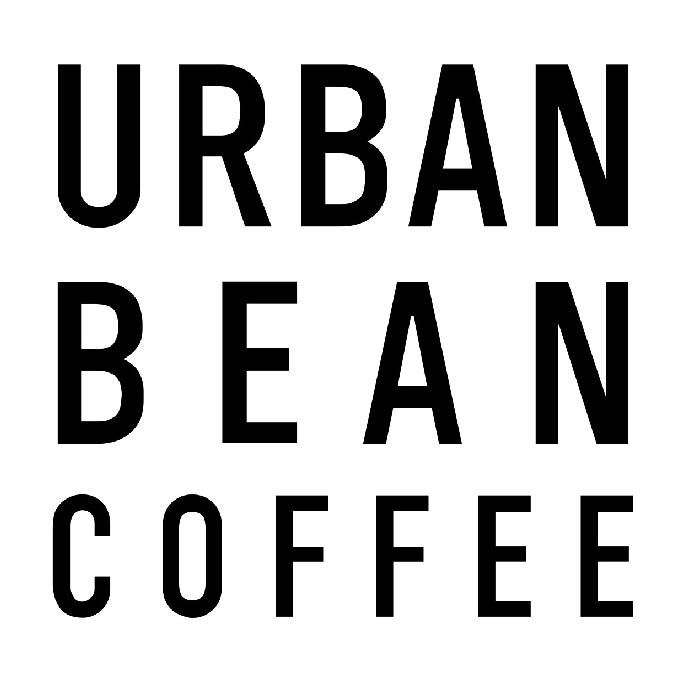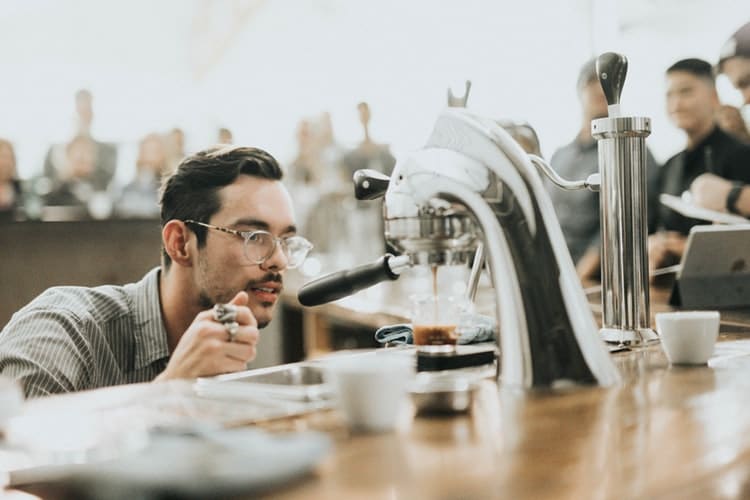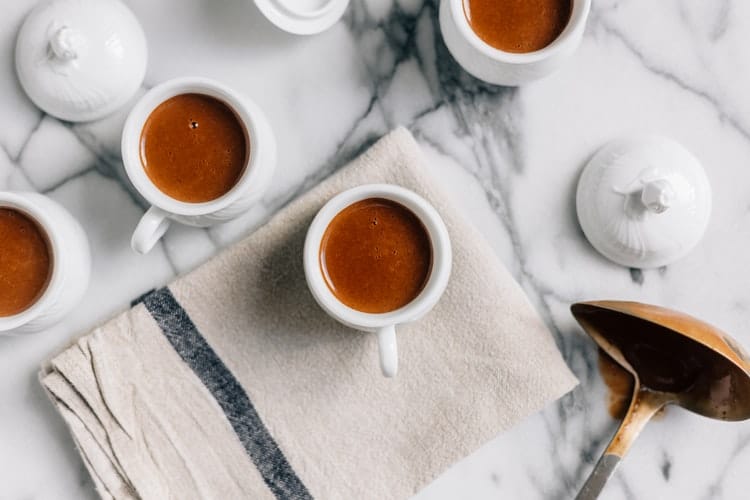Everyone knows what coffee is and, odds are, have also heard of espresso.
However, you may be very surprised if I say that these are two quite different things. The fact is that these two drinks differ from each other in different parameters: the preparation of beans, taste and the presence of caffeine.
If you feel confused, I have prepared for you the basic differences between coffee and espresso that everyone needs to know.
Espresso Vs Coffee – What’s The Difference?
Coffee is the usual liquid that we get from the beans. Espresso can be obtained using a special preparation of Arabica or Robusta beans.
Espresso is a kind of Italian answer to your urgent need for caffeine. The word itself conveys the essence of this drink. “Espresso” can be translated as “fast” or “pressed”, “cooked under pressure.” The drink is instantly prepared in an espresso machine and this shot is instantly drunk.
Now let’s look at the differences in more detail:
1. Brewing time
Typically, coffee roasting takes about 13 minutes, while espresso roasting time is about 20 minutes. Of course, time may vary depending on the type of bean and the roadster model.
2. Appearance of beans
Due to the long-lasting roasting, good espresso beans have a darker color and a shinier surface than coffee beans. The shine is because oils contained in green beans come to the surface during the roasting process. Due to the short roasting, the beans have a lighter color and a matte finish.
3. Acidity
Espresso beans have a weaker acidity. The is because the acids contained in the beans decompose during roasting. Therefore, because of the longer roasting, the acid in such beans is often practically absent. Many of the people whose stomach is more sensitive to acidity prefer espresso rather than traditional coffee.
4. Pressure
The espresso itself was invented to speed up the process of making coffee in bars. For this, the pressure is used.
Water passes through the ground coffee under pressure, at least 9 bar. The water temperature is 190-196°F. Water is usually used to make common coffee with a high temperature of 195-205°F and the beverage is prepared without high pressure. Interestingly, the pressure is the reason why paper filters are not used in the preparation of espresso. Paper simply cannot withstand such pressure.
5. Differences grinding and extraction
Another important difference is grinding. For espresso, the beans should be much smaller than for coffee. This is because it is prepared much faster – only 25-30 seconds. Thus, the contact of ground beans with hot water is much shorter.
Passing hot water under high pressure through very finely ground beans gives a more efficient extraction. So, when preparing an espresso, about 24% of all substances are extracted from the beans, while only 17% is extracted when making drinks.
6. Brewing time
The fineness of espresso grinding is set in such a way that it with a volume of 30 ml is extracted in 25-30 seconds, after 1.5-2.5 seconds of pre-infusion. Coffee preparation can take up to 6 minutes.
7. Brewing temperature
When brewing espresso, the water temperature is controlled by the thermostat of the espresso machine and should be between 190 and 196 degrees Fahrenheit. In the case of coffee, the temperature should be between 195°F and 205°F. The closer to 205°F, the better. Never use boiling water (212°F), as this will burn the beans.
Keep in mind that if the frozen beans have been ground, the unit will lower the temperature of the water upon contact. In this case, the temperature of the water added to the aggregate should be right at 205°F.
8. Which one has more caffeine?
Due to the longer roasting of espresso beans, their caffeine content is lower than in the best coffee beans. Also, the volume of a regular espresso cup is only 30 ml. Of course, with the same volume of drinks – espresso will contain more caffeine.
However, when comparing two drinks per ounce, and not per serving, it contains significantly more caffeine. Despite the smaller amount of caffeine in one cup, the espresso concentration is higher. All because of the ratio of water to ground beans. When making espresso, 1 milligram of ground coffee uses less water.
9. Difference between espresso and drip coffee
Espresso and drip coffee theoretically have the same concept. The basics are the same: hot water is poured through ground beans through a filter of some form, and the coffee drink goes straight into the cup.
But the key difference between drip coffee and espresso is that when preparing espresso, water is passed using pressure, and in drip, water passes through ground beans simply through gravity. Therefore, the process of brewing in a drip maker takes a little longer and the output is quite different. Despite this, drip coffee still produces an excellent result.
Drip coffee, also known as “pour-over,” slightly reduces acidity and brings out the more complex flavors in coffee. Therefore, it gained its popularity through its preparation. And, unlike espresso with its density and layers, good filter coffee is clean and consistent. In addition to lower acidity, drinks have a moderate taste, at least when compared to espresso.
Espresso Types
Doppio
There is nothing remarkable in this drink, it is just a double portion of regular espresso. To mitigate the strength of taste, some like to add sugar, especially cane sugar.
Ristretto
This drink has a high dose of caffeine. It achieves this through its preparation of 5-6g of coffee through no more than 25ml of water.
Macchiato
This is not the giant drink in the coffee house, although it may sound like it. The classic version of Macchiato is two ounces of espresso with the addition of foamed milk. It is very popular in Italy. Usually, before trying a strong drink, people take a couple of sips of water to maximize taste.
Lungo
This is something in between double espresso and americano. The volume of the portion is usually about 70 ml and increases due to water. This makes the drink less strong.
Corretto
In a standard portion of espresso, add a large spoonful of strong alcohol, usually whiskey or brandy. Sometimes gin or vodka are used instead. Such a drink is customary to drink in the cold season after the end of the meal. To soften the taste, it is not forbidden to add sugar or even honey.
Romano
Prepared using standard espresso, this drink is served with a lemon slice or a curled strip of lemon peel to add zest. This drink is famous for invigorating and increased tonic action because it has a high content of caffeine and a refreshing finish.
Is espresso bad for health?
In short, no. Espresso, like black coffee, brings much more benefits than problems. At a basic level, it contains a lot of antioxidants and few calories, which gives obvious advantages.
Also, it improves concentration, long-term memory, and mood. Studies have shown that it can reduce the risk of stroke and type 2 diabetes. Some people even use this drink to increase energy during workouts.
It is safe to say that this drink does not spoil your health, but do not abuse it since excessive use of caffeine can adversely affect your health.
Conclusion
We looked at the main differences between coffee and espresso to hopefully help you to understand what makes them unique.
Now it’s your turn.
What do you prefer: coffee or other drinks? Which type of espresso will you try?
You can leave a reply and I will be happy to talk to you.



Thanks, John for sharing a great difference between coffee and espresso.
Np Robert. Glad to help.
I personally prefer drip coffee as it does is less acidic in nature and for regular drinking, it seems a lot easier to make. Most of the homes in America are equipped with drip coffee makers rather than the giant espresso machines.
It’s true Fred.
We also researched it not that long time ago.
So, I’m pretty sure you’ll find something interesting for yourself.
Such an amazing article now I came to know the difference between Coffee and Espresso. Would you like to please tell me which machine is best for Espresso?
Thank You !!
Thanks, Christopher.
Check our article – https://urbanbeancoffee.com/espresso-machine/ there is a lot of information about espresso machines.